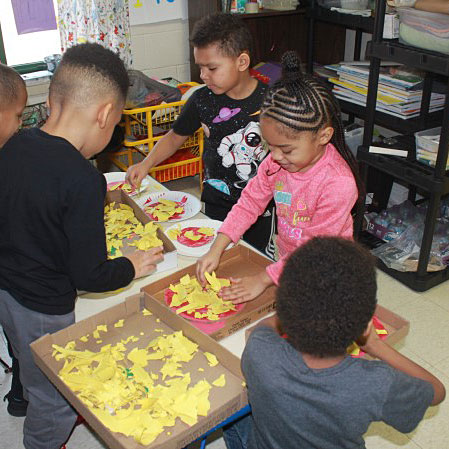Mary Keltner
Valeska Hinton Center
Peoria, IL District #150
2020
During the school year our class had been focusing on partnering with the life skills and autism class near our classroom. In December my class, Green 2, completed a Baking Project. As that project progressed, fellow teacher Ellen Ramsey and I discussed the possibility of collaborating with her two half-day special education classes. Her classroom is in nearby Green 3. Our classrooms had previously partnered in decorating cookies by using a pendulum and enjoying the cake at a surprise birthday party.
Since Green 2 had been investigating baking, we decided that extending the investigation into cooking something of high interest to most of the children might be a good topic for our collaborative project. We decided on pizza. We knew that had been a successful topic for other teachers (see The Pizza Project).
Phase 1: Beginning the Project
Ellen’s morning life skills class and her afternoon special education class invited our children to come to their room and help make a pizza from scratch. The children from Green 2 modeled how to vote for a favorite topping and participate in a class conversation (see Figure 1). They worked hand over hand with children from the other class to make a pizza.
This project is just one example of how we are gaining exposure and building relationships among the children in the three classes. We were so pleased with the way our class is developing empathy for other children that need additional assistance.
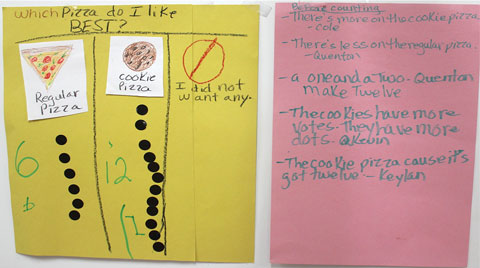
During our investigation of pizza, the children in Green 2 read The Little Red Hen Makes a Pizza by Philomen Sturges. As we read this story, the children started to make the connection that raw products (tomatoes, grains, milk) become the ingredients for a pizza. To help build this understanding, we made a bridge map that identified similarities. In their map (see Figure 2), the children would say, “Tomatoes make red sauce, as flour makes dough, as milk makes cheese.” After they mastered this concept, we were able to expand on their understanding of what raw products were processed into other ingredients.
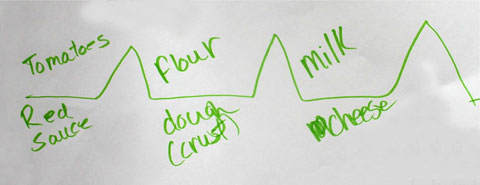
As part of our Pizza Project, the children wanted to find out how the teachers and staff in the building cut their pizza. There are five classrooms in each wing of our building. The children were divided into groups of five, and each group surveyed a different wing. Each child took a turn asking a staff member how they cut their pizza. Then they worked as a group to record their findings (see Figure 3).
After collecting their data, the children deciphered the information and discussed it as a group. To help them interpret their data, we taped the papers together in a line and counted all the dots. Children volunteered to write the number that represented how many dots were in each row. We talked about which row had more and which row had less. They found that all the adults in one wing cut their pizza with a pizza cutter.

Phase 2: Developing the Project
Two guest experts, Miss Jasmine and Mr. James, visited our class during the Pizza Project. We were able to share some of this experience with Miss Ellen’s class. Miss Jasmine’s visit focused on how a pizza is made, and Mr. James’ visit focused how a pizza is delivered. In anticipation of their visits, the children brainstormed several questions. The question that was most interesting to them focused on how a pizza is kept warm as it’s delivered. The class developed several hypotheses, including that the car motor keeps the pizza warm (see Figure 4). Each child voted “yes” or “no” to show whether they thought this prediction was correct. After voting, we presented the questions to Miss Jasmine and Mr. James along with several other questions (see Figure 5).
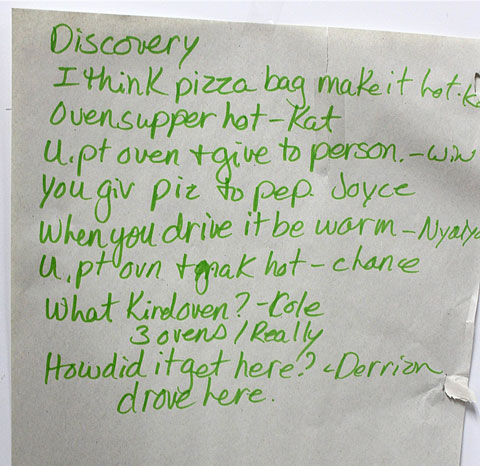
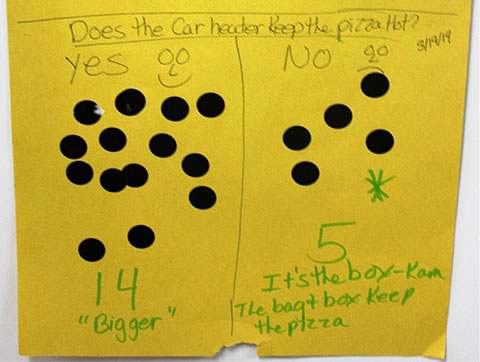
We created a flow map to help the children process how the pizza would arrive at school. A flow map provides a visual explanation of the sequence of events. We talked about the word sequence and brainstormed what would happen first, second, third, etc. I drew simple pictures to represent the children’s words (see Figure 6).
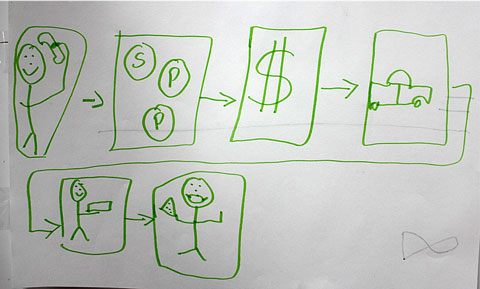
Because of the length of this project, we periodically asked the children to brainstorm the things they would like to learn more about. This allowed the teachers to make sure our project was still relevant to the interest of the class, and it guided our instruction regarding where to go next with the project.
As our project continued, the children in Green 3 built their own bakery and pizzeria in the dramatic play area. The children created a list of everything that they thought should be sold there and the things they would like to have available to use in this area. With some guidance, the children constructed their own pizzas and baked goods to sell (see Figure 7). The children from Miss Ellen’s classes helped with tearing and gluing the paper on the circles that the children in Green 2 traced and cut out.
Our physical therapy department assisted in facilitating the pizza project. For example, the children from both classes listened to the story “Pete’s a Pizza” by William Steig. After listening to the story, the children participated in a gross motor activity. They made a pretend pizza from fabric, shredded paper, brown pompoms, and fun foam red circles to make representations of pizzas. The children had to assemble the pizza, and talk about the sequence of which topping went first, second, and so forth.
They also learned about this concept by reading and building a flow map. After building their pretend pizza, the children took turns delivering pizza to each other’s classroom and answering the door when the delivery person knocked on the door. This experience assisted the children in practicing social interactions as well as learning to exchange money for items they purchased. This activity was expanded in our activity room (gross motor room) with the use of scooters. The children would hold a pizza box and move across the room using their legs to build core muscles. When they reached a set of steps, they would climb and knock on the door to deliver their pizza. We also worked with our Deaf and hard of hearing classroom to accept pizza deliveries.
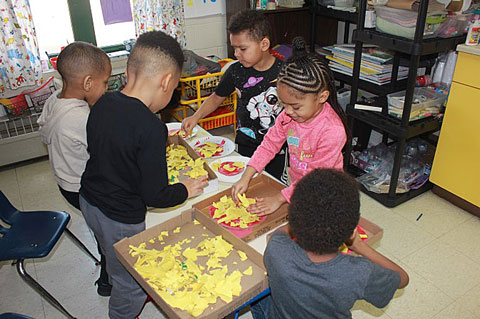
Phase 3: Concluding the Project
At the conclusion of our Pizza Project, the children in Green 3 got to order pizza from two different stores. Our first pizza was ordered from Little Caesars. One student’s mom worked there, and it provided the perfect opportunity to do some hands-on exploration of how pizza is ordered. We began this process with a traditional choice graph (see Figure 8).
However, that did not tell the class how many pizzas we needed to order. So, we took the information from the first graph and moved it over to a pie graph that was divided into eight slices. As we moved their pictures, the children had to figure out whether we needed to add an additional pizza, or if one pizza would be enough to serve the number of children who had selected that type of pizza (i.e., sausage or pepperoni). This process helped the children learned about parts and whole (see Figure 9).
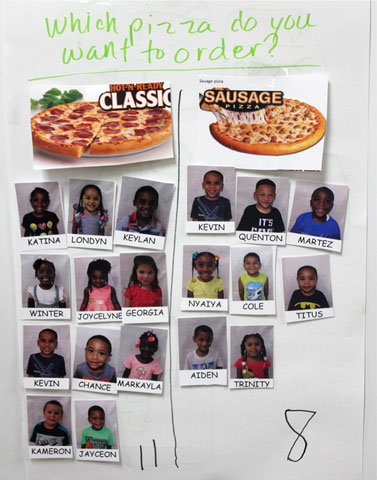
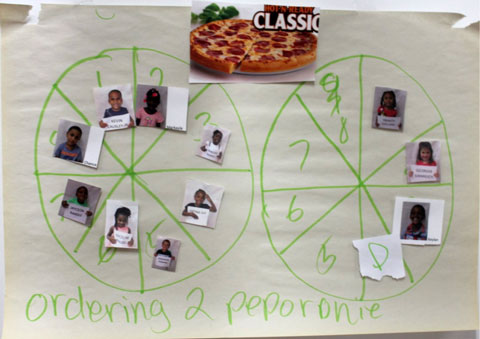
Our class project board was continually updated with the tree maps that the children helped build, as well as artifacts and evidence from their work. We updated the parents in our newsletter, and planned a culminating event for the entire school. We wanted to help them learn about the value of project work.
For this event we created a display of every phase of the project. Both Green 2 and Green 3 were involved in documenting the Pizza Project. Green 3 provided the bulletin board that was used in the showcase and Green 2 contributed the maps and graphs made by our class.
Teacher Reflection
I have worked on projects since the beginning of my career, however this is the only one that has lasted longer than three months. During the previous school year, Ellen and I decided we wanted to work together to provide enhanced learning opportunities for all of our students. This project challenged me to make project work accessible to all students. It challenged me to truly focus on the diverse needs of our population and to adapt my teaching style so that it helped all of our students learn.
I was impressed by the collaboration that took place between students from two vastly different learning environments, and the empathy that developed not only among our students, but also our staff. This project has created a bond of learning that has continued and flourished within other rooms of our school.
During this project, I loved watching typically developing children in our classroom learn to work with the children with disabilities from a neighboring classroom. When their involvement in the project began, the children in the three classes were apprehensive about visiting each other’s classrooms. But by the end of the project, we watched a child who had never before interacted with other children in play sit down and share Legos with another child. We watched as typically developing children learned to accept and help the children who had various tics and needed hand-over-hand assistance and visual aids. They learned patience and empathy.
This project provided a wide variety of methods for assessing the knowledge gained by each child. One little boy’s discoveries will remain an important memory of project work for me for a long time to come. This little boy was full of life, but did not like to answer questions during group time.
During our lesson on figuring out how many pizzas we needed to order, he was the first child to deduce that we needed to order more pizza. He realized that there were more children than one pizza with eight slices could feed. The pride he felt and demonstrated when he provided the answer will remain in my memory forever. This moment seemed to change him and gave him the confidence to participate in whole-class conversations.
IEL Resources
- Project Example: The Pizza Project: A Delicious Learning Opportunity
- Project Example: The Baking Project


